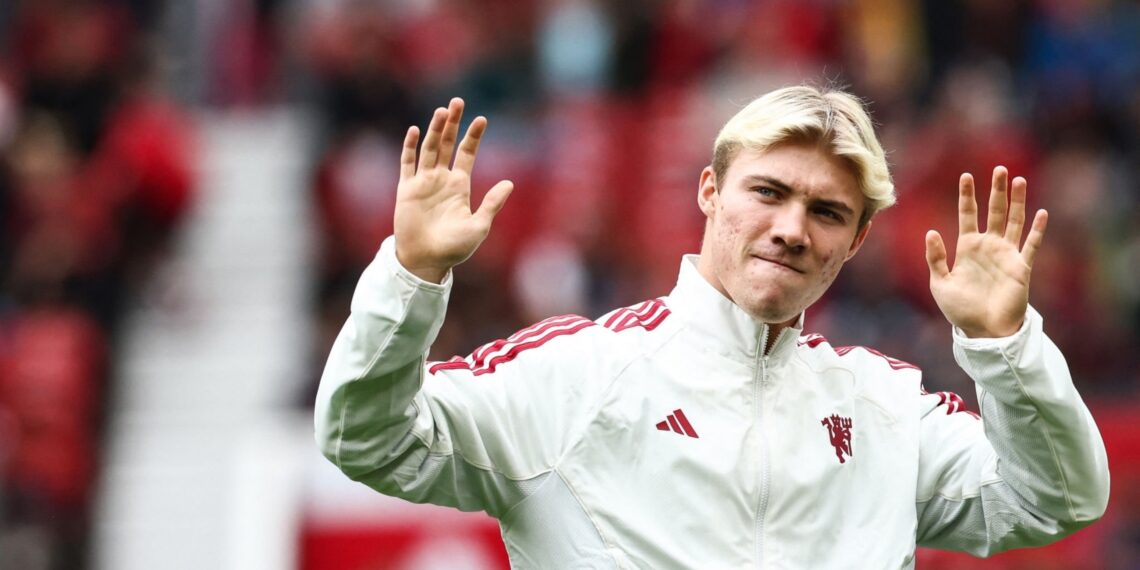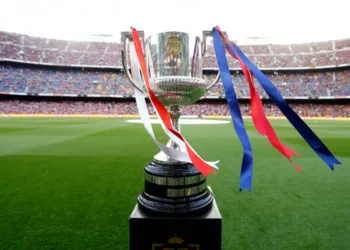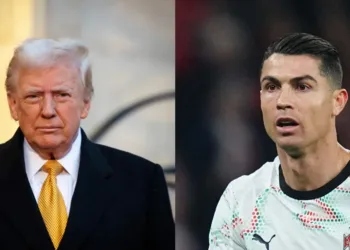Man United have successfully reached a comprehensive agreement with Serie A champions Napoli for the transfer of striker Rasmus Hojlund, with the deal structured as an initial loan with a mandatory purchase clause worth £39 million (€45m). The Danish international has reportedly said ‘yes’ to the move, clearing the final hurdle for his departure from Old Trafford after Manchester United’s acquisition of Benjamin Sesko from RB Leipzig.
The agreement represents a significant compromise from Napoli, who initially preferred a loan with an optional purchase clause but have now accepted Manchester United’s demand for a mandatory buyout triggered by specific performance conditions. The deal is expected to be finalized within 48 hours, marking the end of Hojlund’s challenging two-year stint at Old Trafford.
Table of Contents
Man United Complete Major Squad Restructure with Danish Striker’s Departure
The transfer arrangement demonstrates sophisticated modern football economics, with both clubs benefiting from the structured approach. Man United’s insistence on mandatory purchase conditions ensures they recoup a significant portion of their original £72 million investment in the Danish striker.

| Deal Structure | Details |
|---|---|
| Transfer Type | Loan with mandatory purchase |
| Total Value | £39 million (€45m) |
| Initial Fee | Loan arrangement |
| Purchase Trigger | Performance-based conditions |
| Contract Length | Multi-year agreement with Napoli |
| Player Decision | Confirmed ‘yes’ to move |
The loan will become an obligation to buy for €45m if certain conditions are met, providing Manchester United with security while offering Napoli flexibility in their financial planning. This structure allows both clubs to manage their Financial Fair Play requirements effectively while securing the player’s future.
Rasmus Hojlund’s Manchester United Journey
Hojlund initially joined Manchester United from Atalanta for £72m in August 2023, arriving with considerable expectations as Erik ten Hag’s primary striker signing. However, his time at Old Trafford has been marked by inconsistent performances and limited tactical integration under multiple managers.
The 22-year-old’s career at United has been complicated by injuries, tactical changes, and intense competition for places. Despite showing flashes of quality, particularly in European competitions, he struggled to establish himself as the reliable goalscorer United desperately needed.
| Hojlund’s United Statistics | Performance Data |
|---|---|
| Total Appearances | 48 matches |
| Goals Scored | 17 goals |
| Assists | 4 assists |
| Minutes Played | 2,847 minutes |
| Goals per 90 minutes | 0.54 |
| Transfer Value Loss | £33m potential loss |
Following an abysmal campaign on all levels, the MUFC management was keen to bring in an upgrade on the Dane, and Benjamin Sesko proved to be the answer. The arrival of the Slovenian striker effectively sealed Hojlund’s fate at the club, despite his initial desire to fight for his position.
Benjamin Sesko Factor: Catalyst for Change
Manchester United’s completion of the Benjamin Sesko deal for an initial £66.26m (€76.5m) plus £7.36m (€8.5m) in performance-related add-ons fundamentally altered their striker dynamics. The Slovenian international’s arrival provided manager Ruben Amorim with the clinical finishing ability that had been missing from United’s attack.
Sesko’s proven goal-scoring record in the Champions League and Bundesliga made him an immediate upgrade on Hojlund’s inconsistent performances. The 21-year-old’s physicality, pace, and tactical intelligence aligned perfectly with ten Hag’s attacking philosophy, leaving little room for Hojlund in the squad hierarchy.
The financial investment in Sesko also necessitated squad trimming, with Hojlund representing the most saleable asset to balance the books while maintaining squad quality. This business reality, combined with tactical considerations, made the Dane’s departure inevitable.
Napoli’s Strategic Acquisition
Napoli have reached a preliminary agreement with the former Atalanta player, recognizing his potential to rediscover the form that originally attracted Manchester United’s attention. The Serie A champions view Hojlund as a long-term solution to their striker needs following recent departures.
Antonio Conte’s tactical system at Napoli could prove ideal for Hojlund’s development, with the Italian manager’s track record of improving young strikers providing optimism for the player’s career trajectory. The move back to Italy, where he previously succeeded at Atalanta, offers familiar surroundings and tactical approaches.

The striker has already reached an agreement over personal terms, indicating his enthusiasm for the project and confidence in Napoli’s ability to restore his confidence and goal-scoring consistency.
Financial Implications for Manchester United
The £39 million agreement represents a significant financial loss on United’s original investment, but the club’s hierarchy views it as necessary squad restructuring. The deal allows United to reinvest in other priority positions while clearing substantial wages from their books.
Financial Fair Play considerations played a crucial role in the decision-making process, with the sale providing vital funds for additional transfer activity. The structured payment approach ensures United maintain financial flexibility while securing guaranteed income over the coming seasons.
The loss also reflects broader market realities, where proven Premier League performers often command premium fees that may not be sustainable long-term. United’s willingness to accept the loss demonstrates pragmatic business thinking under INEOS ownership.
Tactical Reasoning Behind the Move
Despite Hojlund initially wanting to stay and fight for his place, it became clear he had joined the likes of Jadon Sancho, Alejandro Garnacho, Antony and Tyrell Malacia as players United want out. This decision reflects deeper tactical incompatibilities rather than purely performance-based judgments.
Ten Hag’s evolved tactical system requires different striker attributes than those Hojlund naturally possesses. The manager’s preference for more dynamic, versatile forwards who can contribute to build-up play made Sesko a more suitable option for United’s long-term strategy.
The Danish striker’s playing style, while effective in certain systems, didn’t align with United’s pressing intensity and positional flexibility requirements. This tactical mismatch, rather than ability concerns, ultimately drove the transfer decision.
Serie A Return: Perfect Environment
Hojlund’s return to Serie A represents a homecoming of sorts, given his previous success with Atalanta before his Premier League move. The tactical sophistication and technical demands of Italian football suit his natural game better than the Premier League’s physicality.
Napoli’s patient build-up play and emphasis on striker involvement in creative phases could unlock Hojlund’s full potential. The reduced physical demands compared to English football may also help him avoid the injury problems that plagued his United career.
The move also offers Champions League football, ensuring Hojlund maintains his development trajectory at the highest European level while potentially reviving his international prospects with Denmark.
Market Impact and Future Implications
This transfer sets important precedents for future Premier League-Serie A player movements, particularly regarding loan-to-buy structures that benefit all parties. The creative financial arrangement could influence similar deals throughout the remainder of the transfer window.
For Manchester United, successfully negotiating guaranteed purchase clauses demonstrates improved transfer business under new ownership. The ability to secure substantial fees for underperforming assets shows strategic planning improvements compared to previous transfer windows.
The deal also highlights Serie A’s renewed financial strength, with top clubs now able to compete for Premier League talent through innovative deal structures that manage immediate costs while securing long-term assets.
Squad Restructuring Success
Napoli’s determination to conclude the deal today reflects their confidence in Hojlund’s ability to succeed in their system, while United’s cooperation demonstrates their commitment to efficient squad management under INEOS leadership.
The successful negotiation represents a win-win scenario: United recover significant transfer funds while clearing squad space, Napoli acquire a proven talent at favorable terms, and Hojlund secures regular playing time in a suitable tactical environment.
This efficiency in player trading could become a template for future United business, balancing squad needs with financial reality while maintaining competitive standards across all positions.
Looking Ahead: New Beginnings
With the Serie A champions aiming to close the deal by Wednesday, both clubs are positioning themselves for successful seasons ahead. United can now focus entirely on integrating Sesko while exploring additional reinforcements in other positions.

For Hojlund, the move represents an opportunity to rediscover the form that made him one of Europe’s most sought-after young strikers. Napoli’s faith in his abilities, demonstrated through their substantial financial commitment, should provide the confidence boost needed for career revitalization.
The successful completion of this complex transfer also demonstrates modern football’s evolution toward more sophisticated deal structures that benefit all stakeholders while managing financial risks effectively.
Read More: Lucas Vazquez Completes Sensational Move to Bayer Leverkusen After Real Madrid Exit
FAQs
What is the total value of Rasmus Hojlund’s transfer to Napoli?
The deal is structured as a loan with a mandatory purchase clause worth £39 million (€45 million), triggered by specific performance conditions during his time at Napoli.
Why is Manchester United selling Rasmus Hojlund after signing Benjamin Sesko?
United signed Benjamin Sesko for £66.26 million as an upgrade on Hojlund, making the Danish striker surplus to requirements and necessitating his departure for squad balance and financial reasons.
How much money will Manchester United lose on the Hojlund transfer?
United originally paid Atalanta £72 million for Hojlund in 2023, meaning they will lose approximately £33 million on the transfer if the full £39 million fee is realized.
When will the Rasmus Hojlund to Napoli transfer be completed?
The transfer is expected to be finalized within 48 hours, with Napoli aiming to complete all formalities by Wednesday according to recent reports.
What type of deal structure have Manchester United and Napoli agreed?
The agreement involves an initial loan arrangement that becomes a mandatory £39 million purchase when specific performance-based conditions are met during Hojlund’s time at Napoli.








